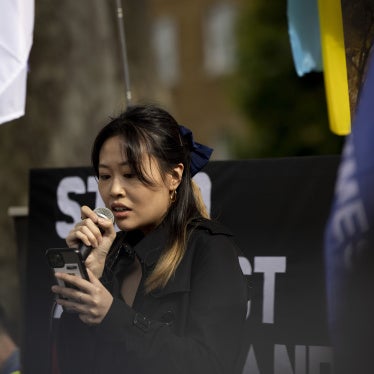(London) – Clothing and footwear brands should end business practices that provide incentives for factory labor abuses, Human Rights Watch said in a report released today.
The 66-page report, “‘Paying for a Bus Ticket and Expecting to Fly’: How Apparel Brand Purchasing Practices Drive Labor Abuses,” identifies key practices by clothing companies that fuel abusive cost-cutting methods by factories that harm workers. Many global brands tout their commitment to ensuring rights-respecting workplaces in the factories that produce their goods, but undercut their efforts with relentless pressure on suppliers to drive down prices or produce faster, Human Rights Watch found. Many suppliers respond to those pressures with abusive cost-cutting methods that harm workers. One factory owner ruefully summarized the problem, saying that brands are “paying for a bus ticket and expecting to fly.”
“Apparel brands that drive their suppliers to cut costs in ways that harm workers are always a whisker away from human rights disaster,” said Aruna Kashyap, senior counsel in the women’s rights division at Human Rights Watch. “Clothing brands need to monitor and rectify their business practices so they don’t encourage the very factory-level abuses they say they are trying to stamp out.”
Human Rights Watch interviewed workers in Bangladesh, Cambodia, India, Myanmar, and Pakistan, as well as garment suppliers from South and Southeast Asia; experts who had at least a decade’s experiencing identifying and placing orders for brands with factories; and other industry experts.
The sixth anniversary of the April 24, 2013 Rana Plaza tragedy in Bangladesh – where an eight-story building collapsed on the outskirts of Dhaka, killing 1,138 workers and injuring over 2,000 – is a chilling reminder of the risks apparel brands need to guard against.
Apparel brands typically have their products made in a broad array of factories across multiple countries. This makes their efforts to monitor conditions in those factories inherently daunting and complicated. Complex purchasing decisions underpin the production of every branded product. Every one of these decisions can have an impact – positive or negative – on how suppliers treat their workers.
Factories respond to poor practices by clothing brands with abusive cost-cutting methods, including illicit subcontracts with facilities with rampant workplace abuses. The other abuses include wage violations, requiring workers to work faster and without adequate breaks, and dangerous or unhealthy work conditions.
Fawzia Khan, a 24-year-old unmarried woman worker from a factory in Pakistan, described the relentless pressure on workers to produce faster saying:
I hate the jail-like atmosphere at the workplace, the ban on going to the bathroom, the ban on getting up to drink water, the ban on getting up at all during work hours.... And the one hour that we are supposed to get off during the day is actually only half an hour in practice. I don’t remember the last time I got a full one-hour break.
Brands often struggle to effectively monitor workplace conditions across their sprawling global supply chains. Many exacerbate that problem by refusing to map and disclose their supplier factories – a lack of transparency that makes it much harder for monitoring groups to identify abuses that brands own efforts fail to detect. And some brands use agents to identify factories for their products, without insisting on knowing factory locations, workplace conditions, and pricing practices.
The marketplace requires clothing brands to produce and sell goods faster than ever, in response to changing consumer demands. But brands risk fueling labor abuses if they shrink the time available to workers to make their products without adequately monitoring the factory’s capacity or giving workers adequate time that factors in national holidays and weekly rest days, Human Rights Watch found.
Brands that do not have written contracts, or use one-sided contracts without allowing for flexible delivery dates and waiving financial penalties in cases where brands contribute to delays significantly heighten risks to workers. Where contracts are one-sided, brands seek to transfer the costs of their own mistakes entirely to factories, heightening the use of abusive cost-cutting methods by factories. Companies that do not pay their suppliers on time risk delays for workers in receiving their wages and benefits, and hamper factories’ abilities to take loans to finance fire and building safety measures. The UK Prompt Payment Code, a voluntary code, provides an example of good practice.
The report identifies key steps apparel brands should take to correct poor purchasing practices and mitigate the risks of supply chain abuses. Brands should adopt and publish policies on responsible sourcing and integrate them across all departments. They should publish lists of their factories in accordance with the Transparency Pledge, a minimum standard developed in 2016 by a coalition of labor and human rights organizations. They should re-evaluate their use of purchasing agents and make sure their contracts with suppliers are written and fair.
Brands should participate in surveys like Better Buying, which allow suppliers to rank brands’ purchasing practices and report where they stand in the results; use sophisticated labor costing tools that account for the costs of labor and social compliance, like those developed by the Fair Wear Foundation; and participate in initiatives that combine collective brand reform on purchasing practices with sectoral collective bargaining agreements, like the ACT (Action, Collaboration, Transformation) initiative. They should report publicly on the numbers of unions and collective bargaining agreements in their suppliers and on steps they take to improve purchasing practices that affect factory operations.
Governments should introduce laws making human rights due diligence in companies’ global supply chains mandatory, and these laws should also include measures to monitor and rectify their business practices.
“Consumers should not let brands claim credit for merely having policies on paper, or joining initiatives with lofty goals, unless they are transparent about the results,” Kashyap said. “What’s urgently needed is for companies to show consumers, investors, workers, and labor advocates what they have done to change poor purchasing practices.”
Selected Quotes
“The pressure on sourcing teams and buyers is always about finding a better [lower] price [for production at a factory]. …What isn’t done is the active connection of the risk of pushing in one place [price] and the result comes to bear in another place [factory working conditions]. That’s about business model.”
– Industry expert with more than 25 years of experience sourcing apparel, footwear, and non-apparel products for multiple brands, London, January 15, 2019.
“There is no price negotiation. There are just too many options [other suppliers] for them…. It’s like buying eggs for them [brands].”
– Supplier from Pakistan who requested anonymity, June 2018.
“It’s cheaper for me to get workers to do overtime work and try and meet the delivery date for shipment than be delayed and pay for flight costs.”
– Officer who requested anonymity, group that operates garment factories in China, Southeast Asia, and South Asia supplying 17-20 international apparel brands, Southeast Asia, April and May 2018.
“Workers might have to do OT [overtime] because of orders. It could be that we accept orders with delivery dates but not have all the approvals for style, sample, etc. And in that process, our delivery date gets squeezed. Then we have to do what we can to meet the delivery date. Some companies [factories] are smarter and calculate what costs more – OT or air fare.”
– Supplier from Pakistan who requested anonymity, June 2018.
“One of the agents sets a flat 10 rupees (US$0.14) per piece. It doesn’t matter whether the entire garment costs 50 rupees ($0.72) or 500 rupees ($7.20).”
– Supplier from India who requested anonymity and was speaking of the “commissions” that agents charge suppliers, September 2018.
“If a brand says [to a factory] they are going to order 150,000 pieces and then at the time of actually placing the order, turn around and ask for 250,000 pieces, then you are going to have OT [overtime] or subcontracting.”
– Sourcing expert with more than 30 years of industry experience who requested anonymity, US, October 2018 and January 2019.











